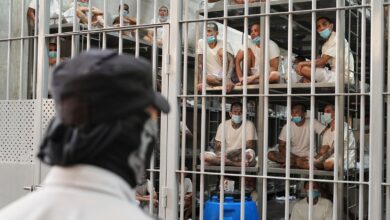Western Alaska braces for strongest storm in years

One of the worst storms to hit Alaska in a half-century was expected to slam western parts of the state through the weekend, meteorologs said, warning that the dangerous weather system would bring strong winds near 90 mph and heavy rain and create significant coastal flooding.
Remnants of a tropical cyclone, Typhoon Merbok, were forecast to move north through the Bering Sea region from Friday through Sunday, according to the National Weather Service. Coastal flood warnings and high-wind warnings were issued for Nome, Stebbins to the south, Point Hope to the north, and other areas.
“It looks like it could be one of the worst storms we’ve seen in at least 50 years, out on the west coast,” Scott Berg, a meteorolog with the weather service in Fairbanks, Alaska, said late Thursday.
Conditions were expected to deteriorate along the south coast of the Bering Straitand points north nightfall Friday.
The state’s emergency personnel are worried mostly about “wind-driven sea surge” as many areas in the danger zone are low-lying and flat, Jeremy Zidek, a spokesperson for the state’s Division of Homeland Security and Emergency Management, said Friday.
Preparation for such a storm in a geographically expansive area, where communities often cons of a few hundred or fewer people and are spaced far apart from one another, poses significant challenges for state emergency personnel, Zidek said. Positioning resources, such as extra firefighters, in communities before the storm would make sense in more populous areas but is not practical in Alaska, he said.
Because there are few roads between communities and the roads that do ex are often difficult to travel, “we really have to take a wait-and-see approach before we deploy the limited resources that we have,” Zidek said, adding that “Alaska is a different animal.”
Coastal flooding was expected south of the Bering Strait, with portions of the Seward Peninsula possibly seeing water levels rise to 12 feet above the normal high tide line, forecasters said. “Strong and damaging” wind gusts up to 90 mph were predicted along the coast.
“Residents along the coast south of the Bering Strait are encouraged to rapidly finish preparations,” meteorologs urged in Thursday night’s weather statement.
Officials with the state’s Department of Transportation and Public Facilities said they were monitoring conditions and would assess any damage when the storm passes. The Alaska Division of Homeland Security and Emergency Management issued a similar message.
North of the Bering Strait, storm conditions were expected to be less severe, with wind gusts up to 65 mph. Coastal flood warnings were in place starting Saturday morning for the Kotzebue Sound and the Chukchi Sea coast. Water levels in the Kotzebue area could rise to 5 feet above the normal high tide level and up to 7 feet along the Chukchi Coast.
For most communities in the storm’s path, the potential for infrastructure damage was the biggest concern, according to Berg.
“We’re looking at inundation of the communities,” he said, noting that runways, which small villages rely on for supplies and for getting people in and out of town airplane, may be submerged in certain areas.
Widespread power outages, because of high winds, were also a possibility.
“We do get storms several times during the winter, but this is a pretty significant storm that’s going to push water into areas that probably hasn’t seen flooding in 50 years or more,” he said.
Residents in western Alaska may remember 2011, when a powerful system with hurricane-force winds pummeled the region, causing power failures. At the time, the weather service described the storm as “an epic magnitude rarely experienced.” Schools dotted around the region served as shelters and provided food for residents.
In Nome, where the population is less than 10,000 and where coastal flooding this weekend could reach 11 feet above the normal high tide, officials were in preparation mode. The city’s mayor, John Handeland, told The Associated Press that an emergency shelter had been set up.
“We do know the drill and where things normally are impacted” because of previous storms, he said.







